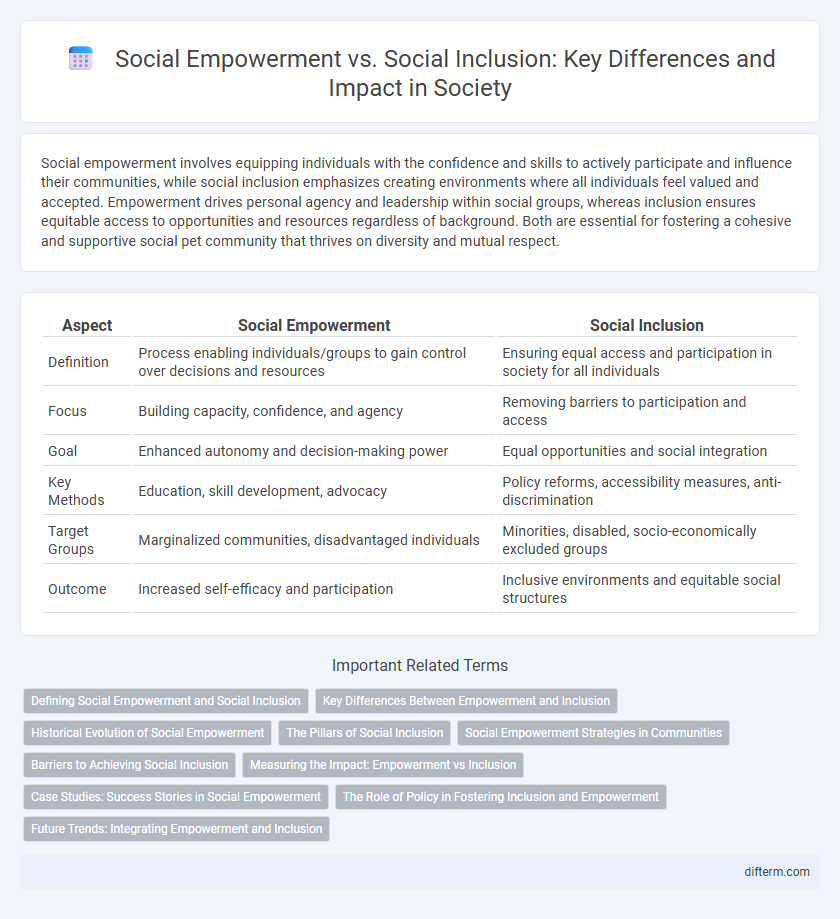Social empowerment involves equipping individuals with the confidence and skills to actively participate and influence their communities, while social inclusion emphasizes creating environments where all individuals feel valued and accepted. Empowerment drives personal agency and leadership within social groups, whereas inclusion ensures equitable access to opportunities and resources regardless of background. Both are essential for fostering a cohesive and supportive social pet community that thrives on diversity and mutual respect.
Table of Comparison
| Aspect | Social Empowerment | Social Inclusion |
|---|---|---|
| Definition | Process enabling individuals/groups to gain control over decisions and resources | Ensuring equal access and participation in society for all individuals |
| Focus | Building capacity, confidence, and agency | Removing barriers to participation and access |
| Goal | Enhanced autonomy and decision-making power | Equal opportunities and social integration |
| Key Methods | Education, skill development, advocacy | Policy reforms, accessibility measures, anti-discrimination |
| Target Groups | Marginalized communities, disadvantaged individuals | Minorities, disabled, socio-economically excluded groups |
| Outcome | Increased self-efficacy and participation | Inclusive environments and equitable social structures |
Defining Social Empowerment and Social Inclusion
Social empowerment refers to the process by which individuals or groups gain the ability, confidence, and resources to make decisions and influence social structures affecting their lives. Social inclusion involves creating equitable opportunities and removing barriers to participation, ensuring marginalized communities can access education, employment, and civic engagement. Both concepts aim to foster equitable societies but differ in focus: empowerment emphasizes personal agency, while inclusion prioritizes systemic access and participation.
Key Differences Between Empowerment and Inclusion
Social empowerment centers on increasing individuals' control over their own lives through access to resources, decision-making, and opportunities, enabling self-advocacy and autonomy. Social inclusion emphasizes creating equitable environments that ensure participation, belonging, and acceptance of marginalized groups within society. Empowerment leads to personal agency, while inclusion seeks systemic removal of barriers to full societal engagement.
Historical Evolution of Social Empowerment
Social empowerment has evolved from grassroots movements in the early 20th century to institutionalized frameworks that emphasize individual agency and community capacity-building. Historical milestones, such as the civil rights movement and global human rights declarations, have shaped policies promoting equitable access to resources and decision-making power. Unlike social inclusion, which focuses on integrating marginalized groups into existing structures, social empowerment centers on transforming power dynamics to enable self-determination and sustained social change.
The Pillars of Social Inclusion
Social inclusion rests on key pillars such as access to opportunities, equitable participation, and the recognition of diversity within communities. These foundations ensure that marginalized groups have the resources, voice, and rights needed to engage fully in societal activities. By emphasizing these elements, social inclusion promotes cohesion and reduces disparities across social, economic, and cultural dimensions.
Social Empowerment Strategies in Communities
Social empowerment strategies in communities prioritize enhancing individual and collective capacities by providing access to education, resources, and decision-making processes, thereby enabling marginalized groups to assert their rights and influence social change. These strategies often include capacity-building programs, leadership development, and community mobilization to foster self-reliance and resilience. Unlike social inclusion, which emphasizes integrating individuals into existing social structures, social empowerment transforms power dynamics to create equitable opportunities and sustained community advancement.
Barriers to Achieving Social Inclusion
Barriers to achieving social inclusion often stem from systemic inequalities, discrimination, and limited access to education and employment opportunities. Social empowerment focuses on enhancing individual capacities and confidence, but without addressing external obstacles like prejudice and social exclusion, inclusion remains unattainable. Overcoming linguistic, cultural, and economic barriers is essential to create equitable environments where marginalized groups can fully participate in society.
Measuring the Impact: Empowerment vs Inclusion
Measuring the impact of social empowerment involves assessing increased agency, self-efficacy, and decision-making power within communities, while social inclusion metrics emphasize access to resources, participation in societal activities, and reduction of discrimination. Quantitative indicators such as employment rates, education levels, and representation in governance provide concrete data for social inclusion, whereas empowerment is often evaluated through qualitative methods like self-reported confidence and community engagement. Effective social policies integrate both frameworks to capture the holistic progress of marginalized groups towards equality and active societal participation.
Case Studies: Success Stories in Social Empowerment
Case studies in social empowerment highlight transformative success stories where marginalized communities gain control over resources, decision-making, and economic opportunities, leading to sustainable improvements in quality of life. Programs such as microfinancing in Bangladesh and community-led education initiatives in Kenya demonstrate how empowerment fosters autonomy and resilience beyond mere social inclusion. These examples underscore that while social inclusion ensures participation, social empowerment actively builds capacity for self-determination and societal change.
The Role of Policy in Fostering Inclusion and Empowerment
Policy frameworks play a crucial role in fostering social inclusion and empowerment by creating equitable access to resources, education, and opportunities for marginalized groups. Inclusive policies emphasize participation, ensuring that diverse voices contribute to decision-making processes, which strengthens community cohesion and individual agency. Empowerment-focused legislation promotes capacity-building and rights protection, enabling individuals to actively engage in social, economic, and political spheres.
Future Trends: Integrating Empowerment and Inclusion
Future trends in social development emphasize integrating empowerment and inclusion to create cohesive, equitable communities. Emerging policies prioritize access to education, digital technologies, and economic opportunities, enabling marginalized groups to participate fully in society. Data-driven initiatives harness social innovation and collaborative platforms to sustain inclusive growth and empower individuals simultaneously.
social empowerment vs social inclusion Infographic

 difterm.com
difterm.com